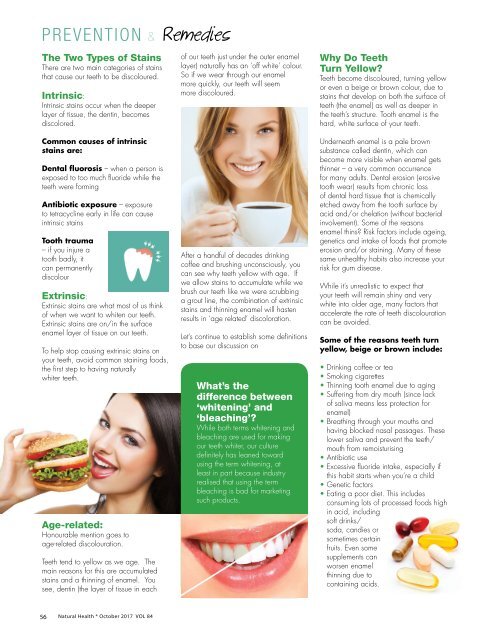Natural Health October 2017
You also want an ePaper? Increase the reach of your titles
YUMPU automatically turns print PDFs into web optimized ePapers that Google loves.
PREVENTION & Remedies<br />
The Two Types of Stains<br />
There are two main categories of stains<br />
that cause our teeth to be discoloured.<br />
Intrinsic:<br />
Intrinsic stains occur when the deeper<br />
layer of tissue, the dentin, becomes<br />
discolored.<br />
of our teeth just under the outer enamel<br />
layer) naturally has an ‘off white’ colour.<br />
So if we wear through our enamel<br />
more quickly, our teeth will seem<br />
more discoloured.<br />
Why Do Teeth<br />
Turn Yellow?<br />
Teeth become discoloured, turning yellow<br />
or even a beige or brown colour, due to<br />
stains that develop on both the surface of<br />
teeth (the enamel) as well as deeper in<br />
the teeth’s structure. Tooth enamel is the<br />
hard, white surface of your teeth.<br />
Common causes of intrinsic<br />
stains are:<br />
Dental fluorosis – when a person is<br />
exposed to too much fluoride while the<br />
teeth were forming<br />
Antibiotic exposure – exposure<br />
to tetracycline early in life can cause<br />
intrinsic stains<br />
Tooth trauma<br />
– if you injure a<br />
tooth badly, it<br />
can permanently<br />
discolour<br />
Extrinsic:<br />
Extrinsic stains are what most of us think<br />
of when we want to whiten our teeth.<br />
Extrinsic stains are on/in the surface<br />
enamel layer of tissue on our teeth.<br />
To help stop causing extrinsic stains on<br />
your teeth, avoid common staining foods,<br />
the first step to having naturally<br />
whiter teeth.<br />
Age-related:<br />
Honourable mention goes to<br />
age-related discolouration.<br />
Teeth tend to yellow as we age. The<br />
main reasons for this are accumulated<br />
stains and a thinning of enamel. You<br />
see, dentin (the layer of tissue in each<br />
After a handful of decades drinking<br />
coffee and brushing unconsciously, you<br />
can see why teeth yellow with age. If<br />
we allow stains to accumulate while we<br />
brush our teeth like we were scrubbing<br />
a grout line, the combination of extrinsic<br />
stains and thinning enamel will hasten<br />
results in ‘age related’ discoloration.<br />
Let’s continue to establish some definitions<br />
to base our discussion on<br />
What’s the<br />
difference between<br />
‘whitening’ and<br />
‘bleaching’?<br />
While both terms whitening and<br />
bleaching are used for making<br />
our teeth whiter, our culture<br />
definitely has leaned toward<br />
using the term whitening, at<br />
least in part because industry<br />
realised that using the term<br />
bleaching is bad for marketing<br />
such products.<br />
Underneath enamel is a pale brown<br />
substance called dentin, which can<br />
become more visible when enamel gets<br />
thinner – a very common occurrence<br />
for many adults. Dental erosion (erosive<br />
tooth wear) results from chronic loss<br />
of dental hard tissue that is chemically<br />
etched away from the tooth surface by<br />
acid and/or chelation (without bacterial<br />
involvement). Some of the reasons<br />
enamel thins? Risk factors include ageing,<br />
genetics and intake of foods that promote<br />
erosion and/or staining. Many of these<br />
same unhealthy habits also increase your<br />
risk for gum disease.<br />
While it’s unrealistic to expect that<br />
your teeth will remain shiny and very<br />
white into older age, many factors that<br />
accelerate the rate of teeth discolouration<br />
can be avoided.<br />
Some of the reasons teeth turn<br />
yellow, beige or brown include:<br />
• Drinking coffee or tea<br />
• Smoking cigarettes<br />
• Thinning tooth enamel due to aging<br />
• Suffering from dry mouth (since lack<br />
of saliva means less protection for<br />
enamel)<br />
• Breathing through your mouths and<br />
having blocked nasal passages. These<br />
lower saliva and prevent the teeth/<br />
mouth from remoisturising<br />
• Antibiotic use<br />
• Excessive fluoride intake, especially if<br />
this habit starts when you’re a child<br />
• Genetic factors<br />
• Eating a poor diet. This includes<br />
consuming lots of processed foods high<br />
in acid, including<br />
soft drinks/<br />
soda, candies or<br />
sometimes certain<br />
fruits. Even some<br />
supplements can<br />
worsen enamel<br />
thinning due to<br />
containing acids.<br />
56 <strong>Natural</strong> <strong>Health</strong> * <strong>October</strong> <strong>2017</strong> VOL 84

















